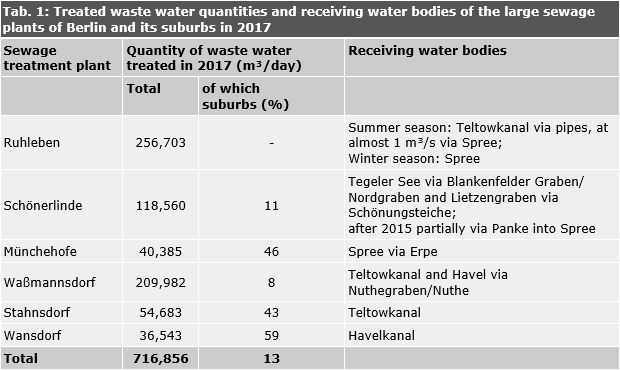In Berlin, precipitation and waste water from private households, public institutions, industry and trade, as well as run-off from public road areas, generate large quantities of rain and waste water. These need to be piped away and treated, if appropriate. In 2017, the sewage plants treated some 717,000 m³ of waste water from private households, trade, industry and public institutions, as well as rainwater from Berlin and its suburban area every day. This quantity is equivalent to a little over 8 m³/sec., or about 15 % of the run-off of Unterhavel river below Berlin, given medium water flow. The amount of waste water generated in Berlin would be sufficient to fill the Great Wannsee lake within three weeks.
Waste waters are carried in a sewerage network with a total length of 9,725 km. The sewerage network is operated by the Berliner Wasserbetriebe (BWB, Berlin Waterworks). It was implemented in two different systems, the combined and the separate sewerage systems, and consists of a total of 4,403 km of waste water drains, 1,928 km of combined water drains and 3,324 km of rainwater drains, as well as numerous special drains and special structures, such as rainwater overflows, rainwater retention basins and culverts. Waste water collected there is pumped to the sewage plants by 163 pumping stations, through a network of 1,183 km of pressurized sewage pipes (Berlin House of Representatives 2015).
Berlin’s combined sewage canal system was built In 1873 according to a design by James Hobrecht, to drain the whole municipal area of Berlin as it was then. However, towns and communities surrounding Berlin, which retained their independence until 1920, mainly built systems based on separate drainage. After their incorporation into Berlin, their facilities were amalgamated into the present system. Drainage areas are oriented towards river courses and shipping canals, and also in accordance with the different terrain heights. The boundaries of drainage areas do not follow the borders of Berlin’s boroughs. About four fifths of Berlin’s drained areas are operated under the separate system, and the remaining fifth under the combined system.
The Separate System
In a system of separated drainage, waste water and rainwater are handled by two different systems. Waste water drains carry household, commercail and industrial waste water to the pumping stations. From there, pressurized pipes are used to take it to the Ruhleben, Münchehofe, Schönerlinde, Waßmannsdorf, Wansdorf, and Stahnsdorf sewage treatment plants. After treatment, sewage plants discharge purified water into Berlin’s bodies of water.
At the pumping stations, there are usually emergency outlets, through which the waste water can be discharged into the receiving bodies of water in case of technical defects. Of the 72 emergency outlets, 26 lead to the Spree, 2 to the Dahme, 19 to the Havel, and 18 to the Teltow Canal; 5 lead to standing surface waters, and 2 emergency outlets lead to other pumping stations, via sewage drains. The performance level of the emergency outlets is very different from year to year.

